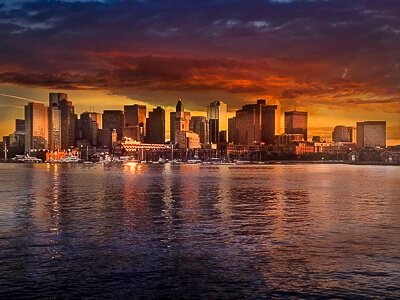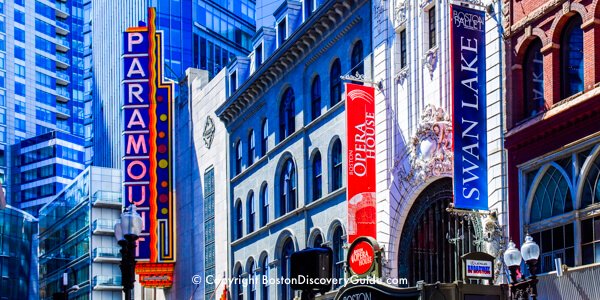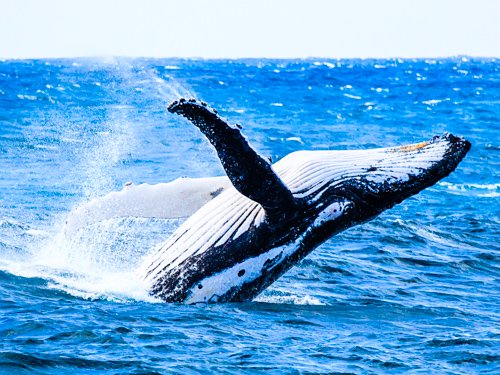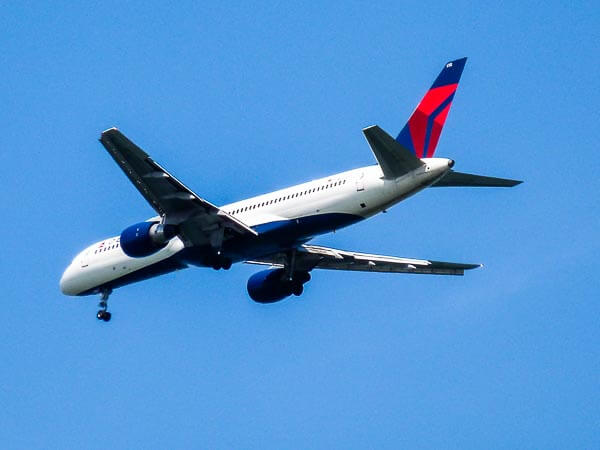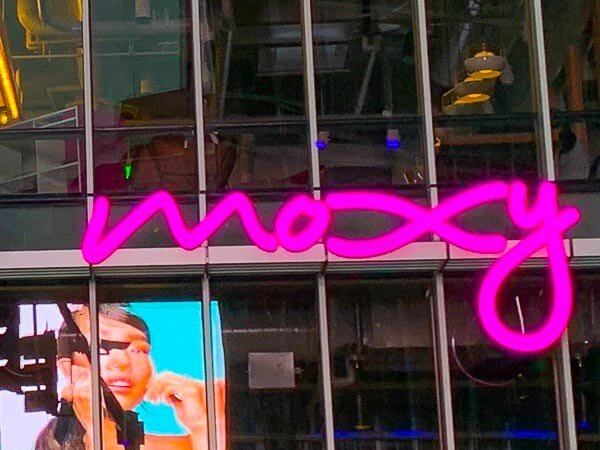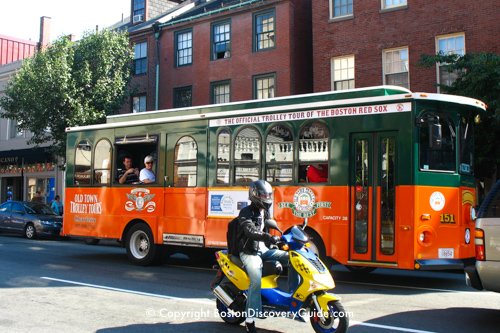Two bombs exploded at the finish line of the 117th Boston Marathon on April 15, 2013, leaving three people dead and 264 injured.
During the following days, even before the police barricades were removed around the blocks surrounding the explosion sites where evidence was being collected, pop-up street memorials began to appear in and around Copley Square.
Soon, people from all over the city, across the state, and around the world gathered to see the Copley Square Marathon memorials and bring their own offerings: flowers, letters, banners, photos, teddy bears, pairs of running shoes, Boston team sports shirts.
Obviously, the memorials were never intended to be permanent. After about 10 weeks, a weather forecast of torrential rain and a desire to preserve as many items as possible for historic reasons caused teams from Boston City Archives to remove them and put them into storage.
A permanent granite, glass, and bronze monument to honor the bombing victims was installed on Boylston Street in 2019.
This article includes photos and content that we first published in 2013, plus new information about the recently installed permanent monument. Quite frankly, continuing to update it all these years later still brings up incredibly painful memories from that time.
So please be aware that some of this article may be triggering for you, because it sure is for us.
Here's what you'll find in the article:
Top photo: Messages transform a Boston Marathon sign into a memorial at Engine 33/Ladder 15 Firehouse at Boylston and Herefore Streets close to the attack site, (c) Boston Discovery Guide
Boston Discovery Guide is a reader-supported publication. When you buy through our links, we may earn a commission at no additional cost for you. Learn more
Photos: Boston Marathon Copley Square Memorials
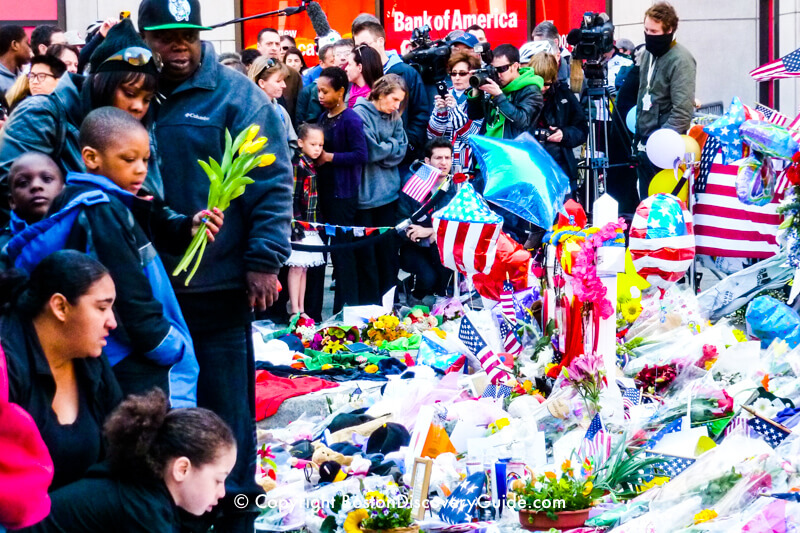
The first pop-up memorials such as this one appeared within a couple of days after the Marathon. Police barricades still blocked off several blocks around the bombing site, so the first flowers and flags were placed by the barriers.
Balloons and stuffed animals commemorated the youngest victim who was only 8 years old.
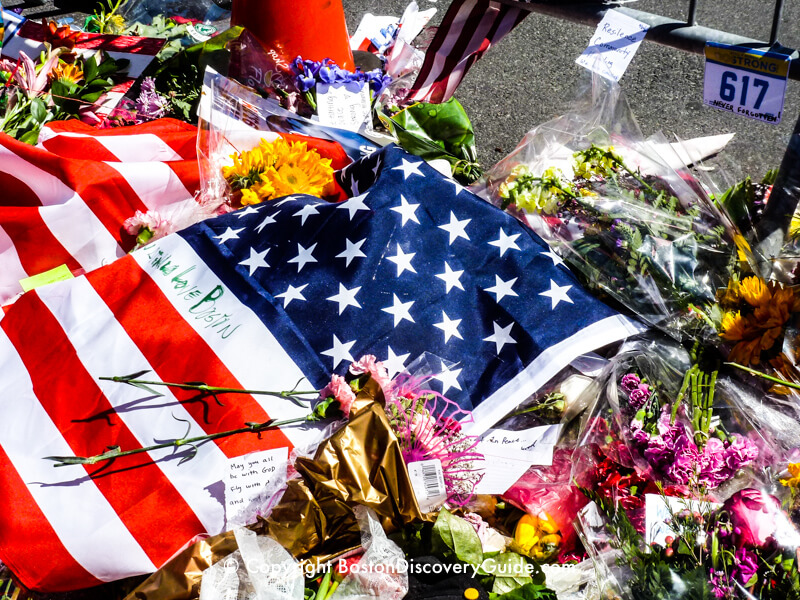
In the midst of chaos and grief, people brought hand-written notes to the victims, the first responders, police and other security forces, and the people of Boston.
The love and caring expressed by the street memorials soon became far more powerful than the bombs.
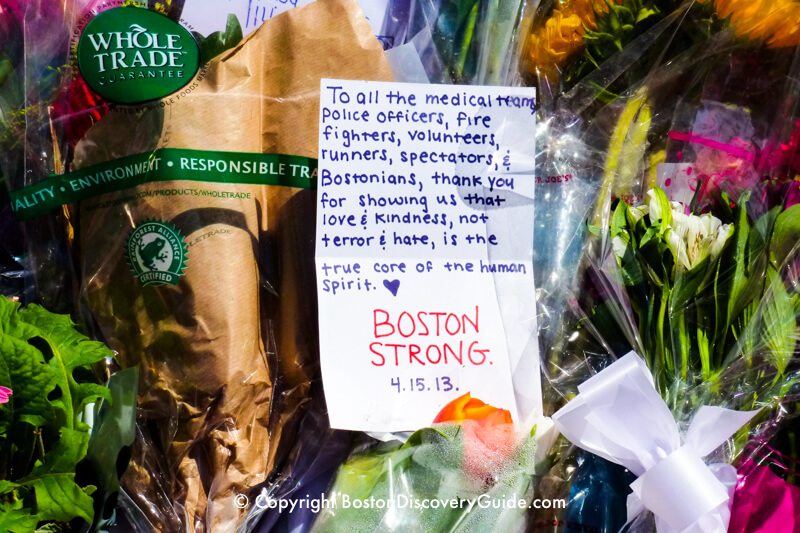
"Boston Strong" became a rallying call.
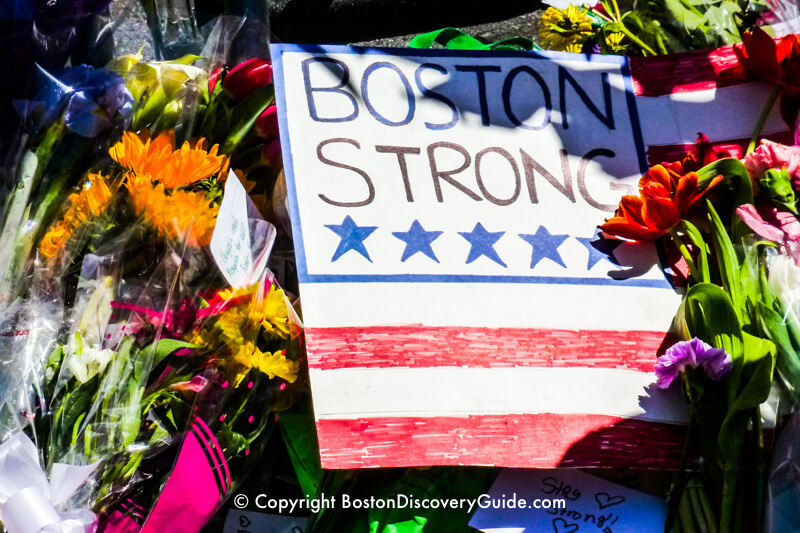
The street memorials grew larger every day as locals and visitors brought flowers, messages, running shoes, stuffed animals, balloons, and other personal objects and icons.
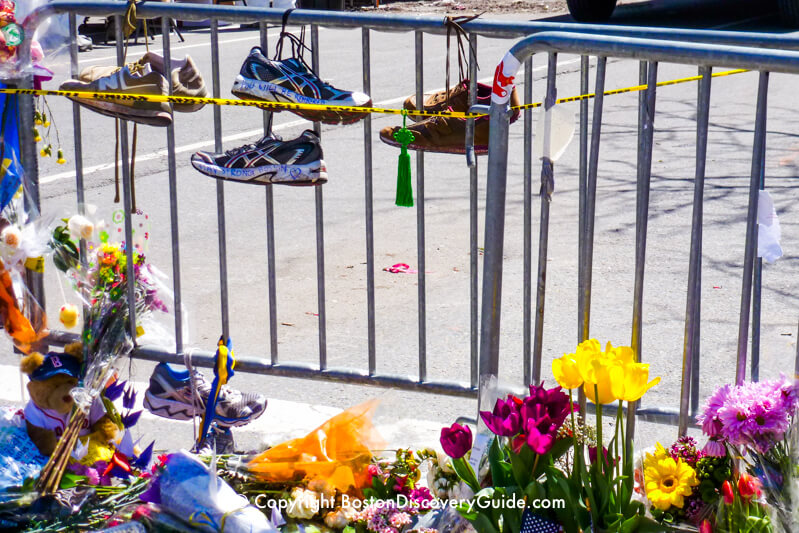
By about the end of the first week, running shoes were becoming a popular item in the memorials.
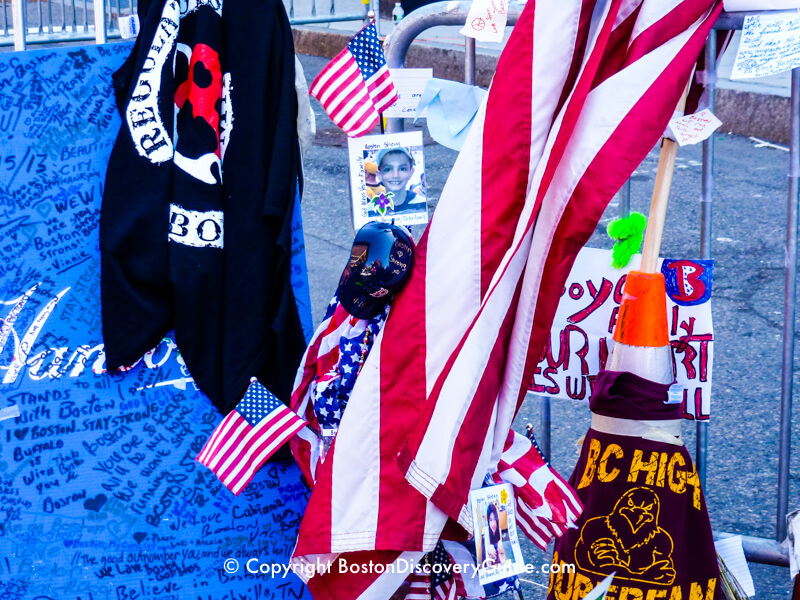
The memorials lined the barricades along Boylston Street where Boston police, the FBI, and other experts continue to collect evidence from the horrific explosions.
After what seemed like "forever," the barricades were finally removed.
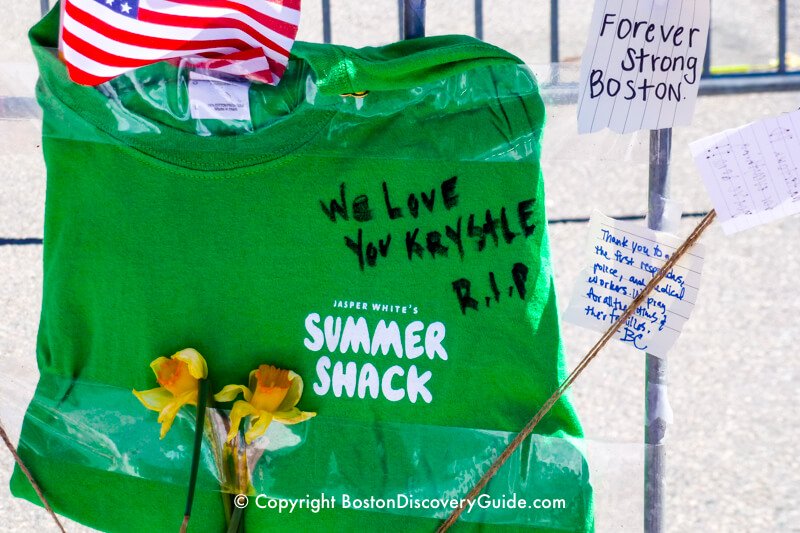
Boston’s April sun was already wilting the flowers, although people continued to bring new ones.
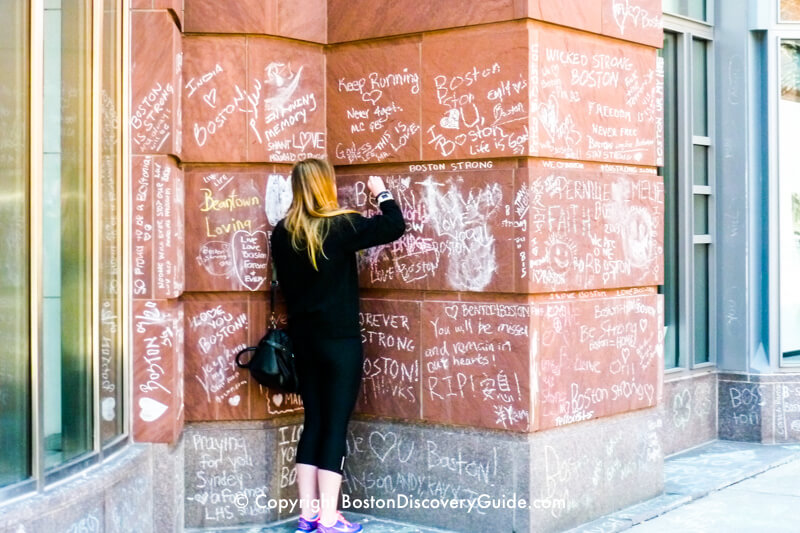
Rain inevitably washed away the messages inscribed with chalk on sidewalks and walls.
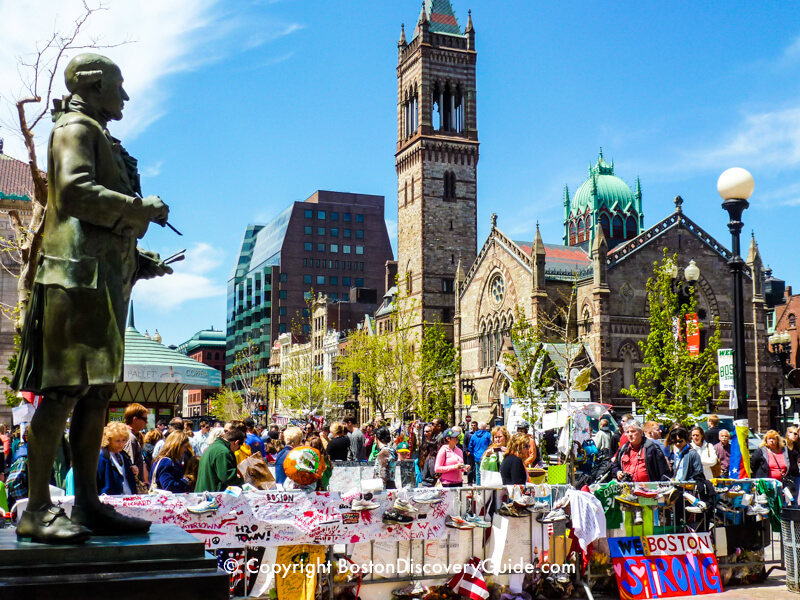
But the Memorials, transplanted to a corner of Copley Square, continued to live and grow. Word spread about the memorials. They soon turned into a sort of shrine.
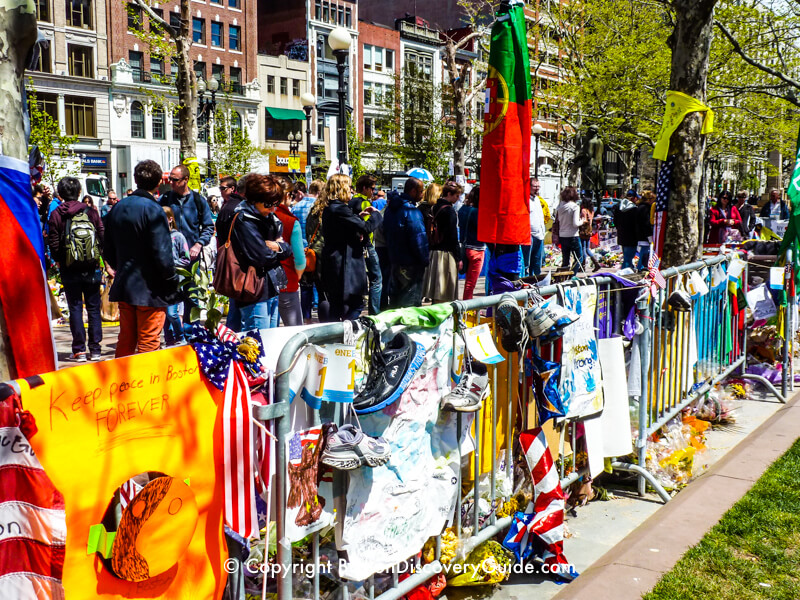
Crowds at the Copley Square site continued to grow too, as the Memorials became a major attraction for Boston residents as well as for visitors from all over the world.
People filed past in slow-moving lines. Some people sobbed as they read the heart-felt messages and looked at all the items.
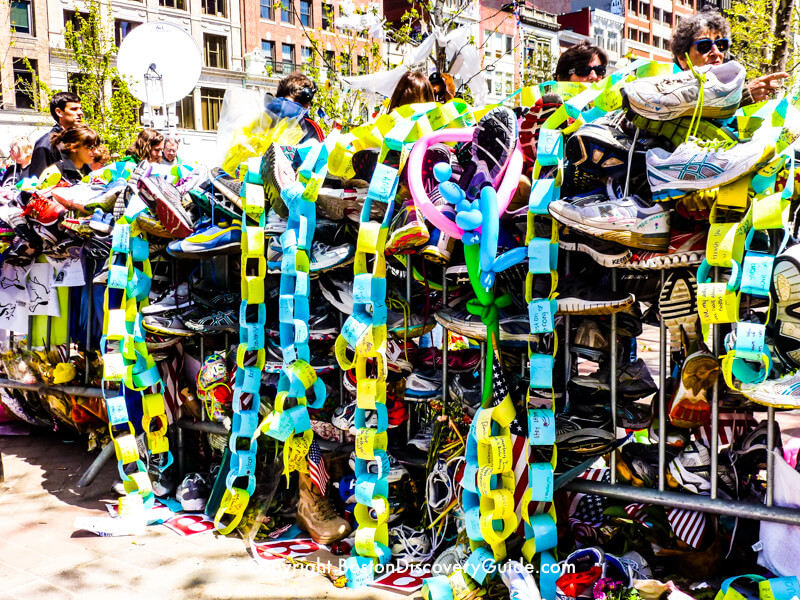
Barricades could no longer been seen under the masses of shoes, shirts (many with sports logos from the victims' favorite Boston teams), garlands, balloons, and signs tied to them.
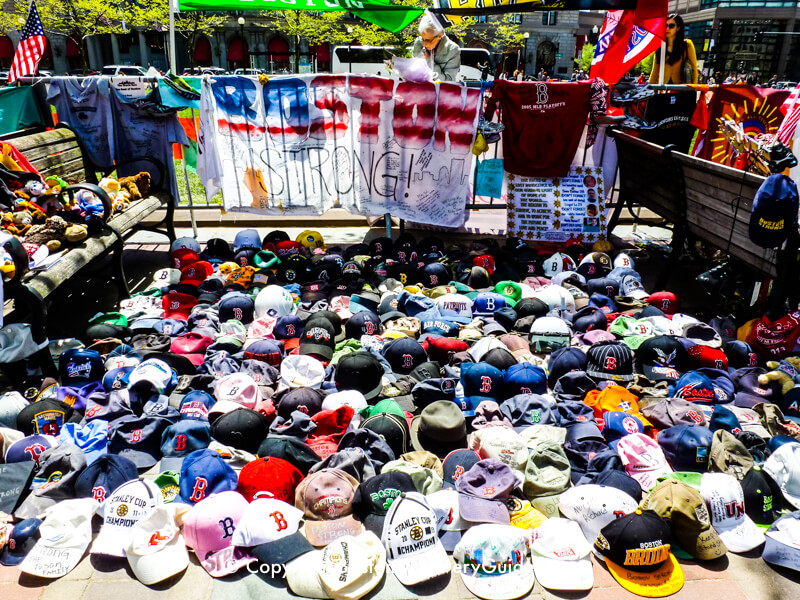
Visitors continued bringing baseball caps, posters, drawings, flowers, photos, candles, and just about everything else imaginable.
Volunteers removed dead flowers and plants every night and tried to organize the other objects by theme.
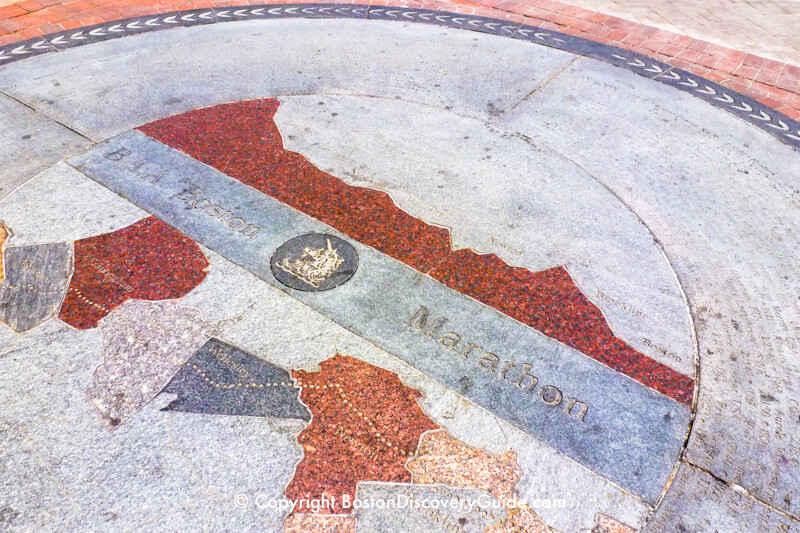
Finally, not long after dawn on June 25, ten weeks and one day after the Marathon, the temporary Memorial was dismantled by about a dozen city officials, volunteers, and archival specialists, who carefully gathered up items for preservation and storage.
Weather forecasts for torrential downpours later in the day provided the impetus for the dismantling, but the time had also come to move forward.
Memorial items are now stored in City Archives and at an additional storage facility in Northborough, MA. The objects fill 286 boxes.
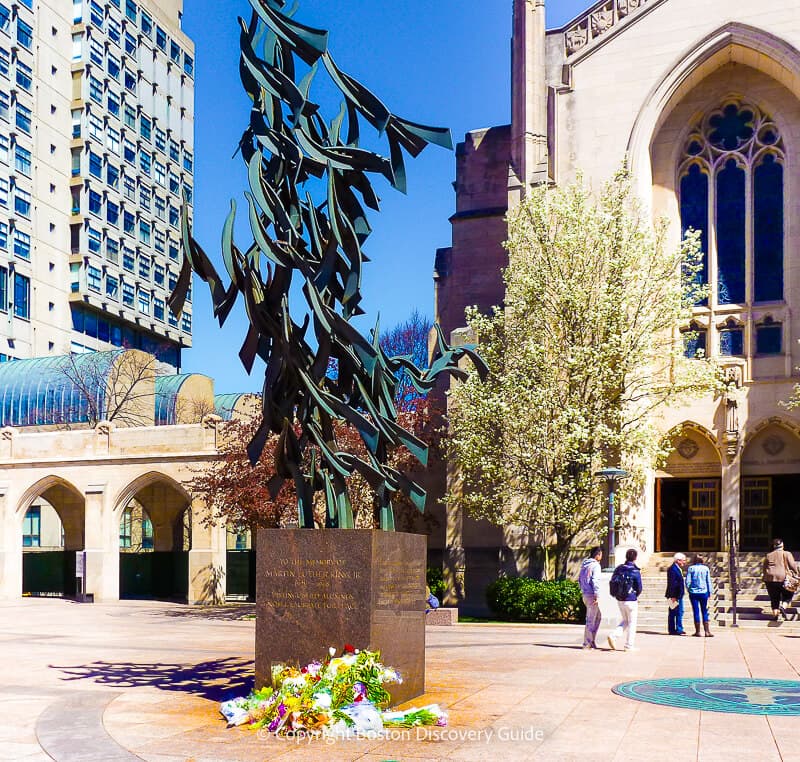
In 2019, a new permanent monument on Boylston Street took its place among all the other Boston monuments that remind us of our city's role in revolutions and wars, achievements and tragedies, heroism and triumph.
From the Boston Massacre site celebrating the first five casualties in the fight for American liberty to the Garden of Remembrance dedicated to all the Massachusetts citizens murdered when the two flights from Boston were crashed into the Twin Towers on 9/11, Boston is a city filled with memorials.
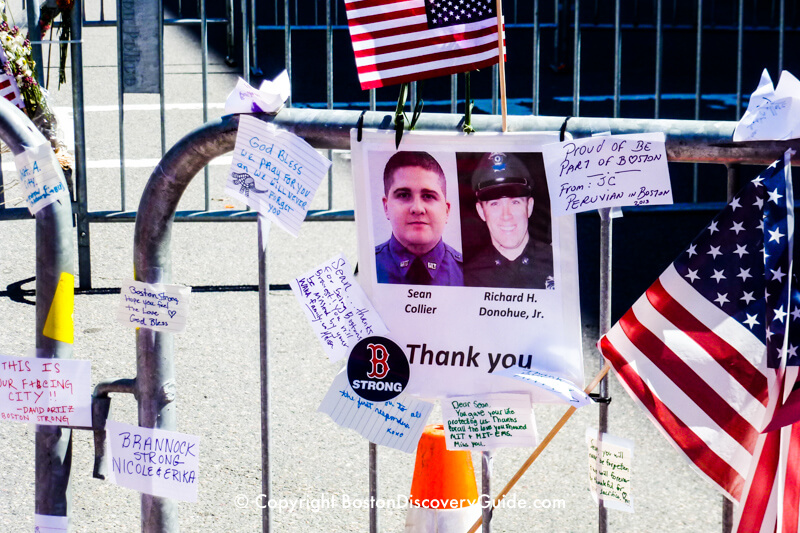
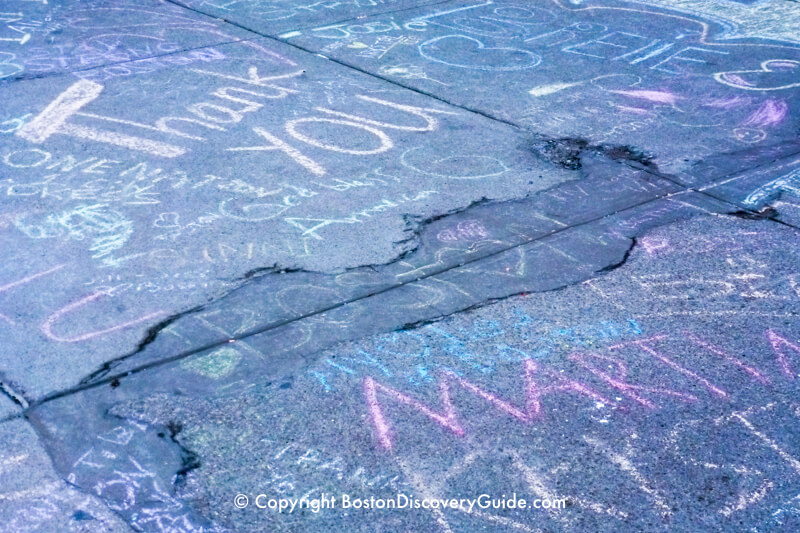
Can a granite monument permanently memorializing the Boston Marathon bombing capture the raw emotions poured into these temporary shrines?
Probably not - at least, not in the same way.
So that’s the purpose of the photos on this page - to remember the outpouring of emotions from the most horrific, most surreal week in Boston’s recent history. To remind us of the love and support that flowed into our city from around the world.
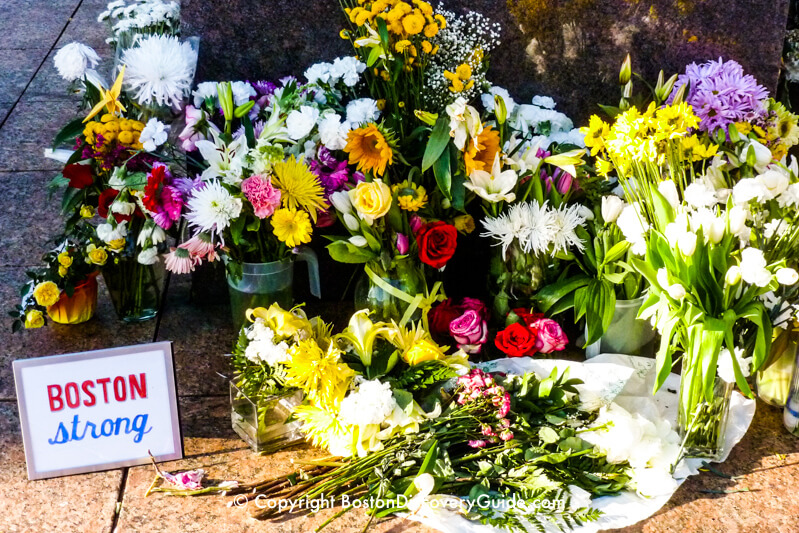
What did these street memorials tell us?
The memorials thanked the first responders who rushed through the smoke to the injured with make-shift tourniquets to staunch the blood.
They thanked the doctors and medical staffs who made sure that everyone who reached the hospitals alive survived.
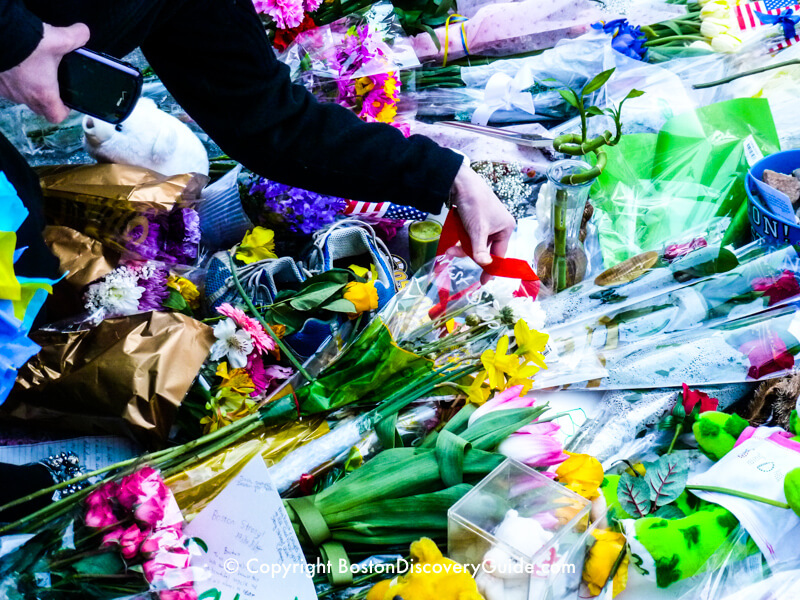
They thanked those who risked their lives to keep our city safe while pursuing the suspects, those who fed and sheltered visitors to Boston who couldn’t return to their hotels inside the barricaded crime zone, those who reached out from all over the world to those of us who live here to make sure we were all right.
They commemorated the spirits of those who are no longer with us.
And they remind us why we celebrate the Marathon every year.
David Ortiz, Boston Red Sox Pitcher, Spoke Out about the Boston Marathon Attack
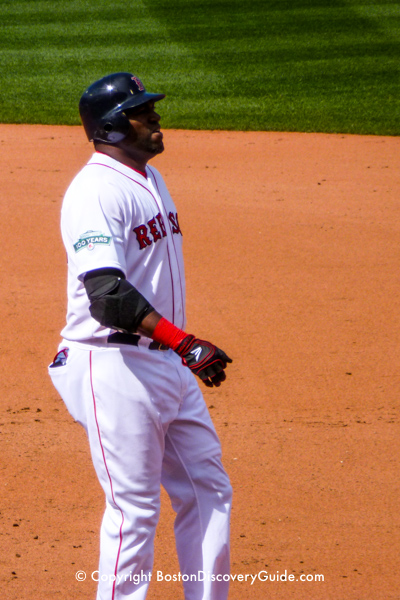
“This jersey that we wear today, it doesn’t say Red Sox. It says Boston,” David Ortiz told the crowd at Fenway park in a ceremony the day after the second Marathon bomber suspect was captured.
In his passionate address, Ortiz thanked the police and the first responders for all their efforts.
But the moment we'll always remember came as he delivered a defiant statement, causing the crowd to roar even louder than when he hit home runs:
"This is our f------g city, and nobody is going to dictate our freedom. Stay strong.”
As Ortiz explained later:
“I’m from the Dominican Republic and the one thing that I always say is me and my family are blessed by being in this country,’’ Ortiz said.
“And I love this country and I would do anything for this country. Everybody was one unit and that’s what matters.”
- David Ortiz, quoted in the Boston Globe, April 20, 2013
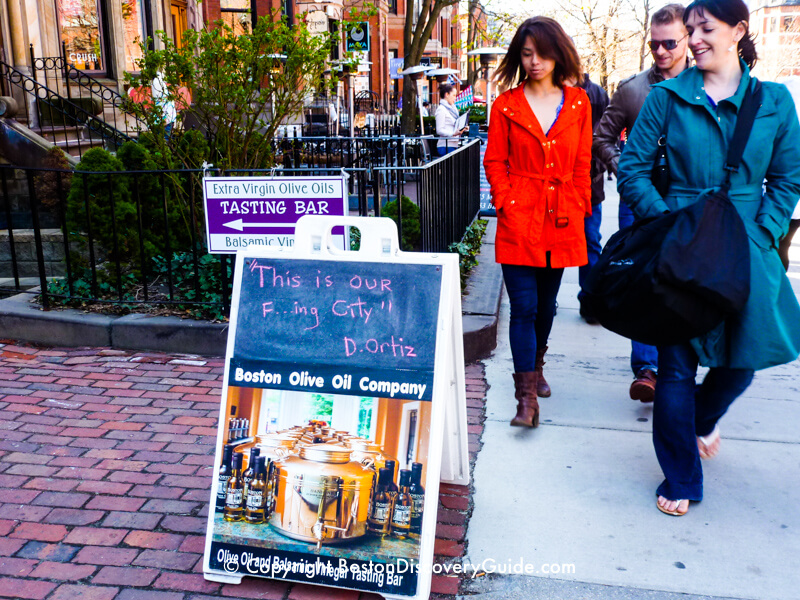
Boylston Street Monument
A permanent monument installed in 2019 near the bomb detonation sites on Boylston Street honors those who died at the Marathon Finish Line as well as the officers who the suspects killed later.
Three granite pillars joined together represent the three initial victims. Each piece of granite is from a local place meaningful to the victims: Franklin Park where 8-year-old Martin Richard used to play, the BU Bridge next to Boston University where 23-year-old Lingzi Lu pursued graduate studies, and Spectacle Island in Boston Harbor where 29-year-old Krystle Campbell enjoyed hiking.
Two bronze bricks set in the sidewalk commemorate the two police officers killed in the aftermath: MIT Officer Sean Collier who the Marathon bombers ambushed and shot, and Boston Police Officer Dennis Simmonds who died from a severe head injury caused when one of the bombers threw an explosive devise at him during the shootout in Watertown Square where the suspects were finally captured.
Four bronze and glass spires soar above the site to illuminate it at night, and newly planted cherry trees will bloom each April, the month when the Marathon takes place each year.
More about the Boston Marathon
Mile-by-mile description of the Marathon route - & best places to see the winners
Yellow Daffodils: A Boston Marathon Tradition Continues Today
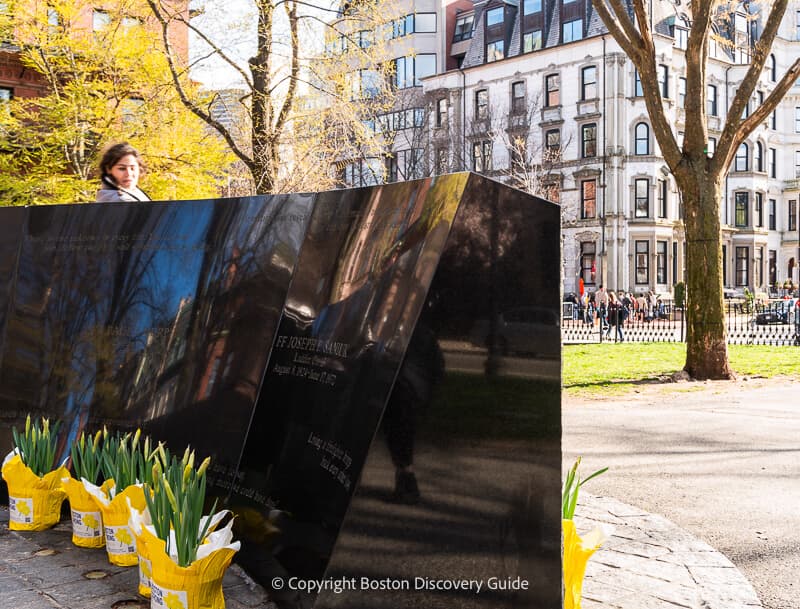
Visit Boston today during the Marathon Weekend, and you're almost certain to see yellow daffodils along the race's route between Hopkinton and Boston's Copley Square, around the finish line, and elsewhere throughout the city.
They symbolize hope, remembrance, strength, healing, and and resilience. Their presence grows each year as they pay tribute to Boston Strong.
A local organization called Marathon Daffodils plants around 30,000 of the bulbs in pots each October. Around April 12, volunteers then distribute them. You'll see them everywhere.
After Marathon weekend, the volunteers plant the daffodils along the the Charles River. Like most daffodil bulbs, these have easily naturalized and multiplied quickly, and now form thick blankets of yellow on the river banks and the Esplanade.
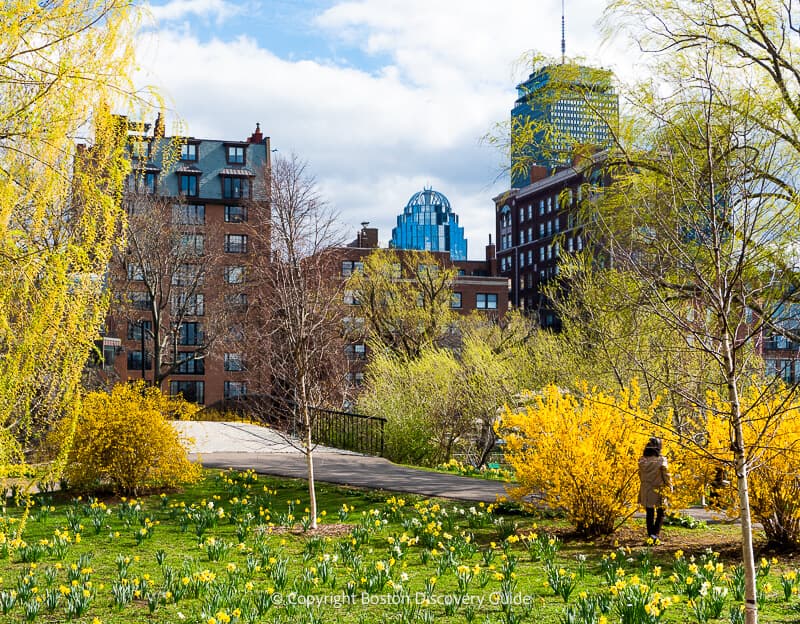
More Marathon Qs & As
- Best RV Camp Near the Boston Marathon - Where to Stay?
- Boston Marathon Race Day Temperature - What Should We Expect?
- Boston Marathon Day Transportation Options: Cab or Subway from Back Bay to Brookline?
- How to Find a Photographer to Photograph a Boston Marathon Runner?
Boston Marathon Hotels
Need a hotel for the next Boston Marathon? Just enter your dates below, and see available rates and hotels on this hotel map from Booking.com:
Booking.comMore about how to save on Boston hotels
More Articles about the Boston Marathon
Find more of our articles about the Boston Marathon:
- Guide to the Boston Marathon - Everything you need to know
- Boston Marathon Route - Mile-by-mile description about what to expect if you're running and including best places to watch if you're a spectator, plus a map
- Boston Marathon Qualifying Times - See what you need to achieve to qualify
- Boston Marathon Weather - What weather conditions might happen on race day (you may be shocked), and tips about training for our weather
- Best Boston Marathon hotels - For runners and watchers


